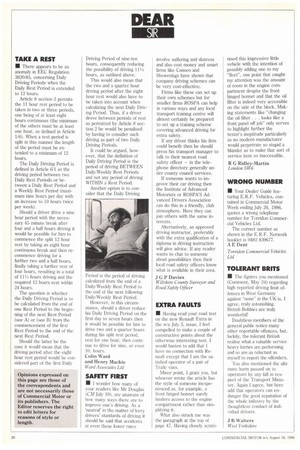TAKE A REST
Page 22

If you've noticed an error in this article please click here to report it so we can fix it.
E There appears to be an anomaly in EEC Regulation 3820/85, concerning Daily Driving Periods when the Daily Rest Period is extended to 12 hours.
Article 8 section 2 permits the 11 hour rest period to be taken in two or three periods, one being of at least eight hours continuous (the minimum of the others must be at least one hour, as defined in Article 1/6). When a rest period is split in this manner the length of the period must be extended to a minimum of 12 hours.
The Daily Driving Period is defmed in Article 6/1 as the driving period between two Daily Rest Periods or between a Daily Rest Period and a Weekly Rest Period (maximum nine hours per day with an increase to 10 hours twice per week).
Should a driver drive a nine hour period with the necessary 45 minute break after four and a half hours driving it would be possible for him to commence the split 12 hour rest by taking an eight hour continuous break and then recommence driving for a further two and a half hours, finally taking a further rest of four hours, resulting in a total of 111/4 hours driving and the required 12 hours rest within 24 hours.
The question is whether the Daily Driving Period is to be calculated from the end of one Rest Period to the beginning of the next Rest Period (see A) or (see B) from the commencement of the first Rest Period to the end of the next Rest Period.
Should the latter be the case it would mean that the driving period after the eight hour rest period would be considered part of the first Daily
Driving Period of nine-ten hours, consequently reducing the possibility of driving 111/4 hours, as outlined above.
This would also mean that the two and a quarter hour driving period after the eight hour rest would also have to be taken into account when calculating the next Daily Driving Period. Thus, if a driver drove between periods of rest as permitted by Article 8 section 2 he would be penalised by having to consider such driving as part of two Daily Driving Periods.
It could be argued, however, that the definition of Daily Driving Period is the period of driving BETWEEN Daily/Weekly Rest Periods and not any period of driving WITHIN a Rest Period.
Another option is to consider that the Daily Driving Period is the period of driving calculated from the end of a Daily/Weekly Rest Period to the end of the next following Daily/Weekly Rest Period.
However, in this circumstance, should a driver reduce his Daily Driving Period on the first day to seven hours then it would he possible for him to drive two and a quarter hours during his split rest period, rest for one hour, then continue to drive for nine, or even 10. hours.
Colin Ward and Henry Mackie
Ward Associates Ltd
SAFETY FIRST
• I wonder how many of your readers like Mr Douglas (CM July 19), are unaware of how many ways there are to improve one's driving. As a 'neutral' in the matter of lorry drivers' standards of driving it should be said that accidents at even these lower rates involve suffering and distress and also cost money and smart firms like Conoco and Showerings have shown that company driving schemes can be very cost-effective.
Firms like these can set up their own schemes but for smaller firms ROSPA can help in various ways and any local transport training centre will almost certainly be prepared to set up a training scheme covering advanced driving for extra safety.
If any driver thinks his firm could benefit then he should press his transport manager to talk to their nearest road safety officer — in the telephone directory generally under county council services.
If someone wants to improve their car driving then the Institute of Advanced Motorists or ROSPA'S Advanced Drivers Association can do this in a friendly, club atmosphere. Here they can join others with the same interests.
Alternatively, an approved driving instructor, preferably with the extra qualification of a diploma in driving instruction will give advice. If any reader wants to chat to someone about possibilities then their local road safety officers know what is available in their area.
G P Davies Wiltshire County Surveyor and Road Safety Officer




































































